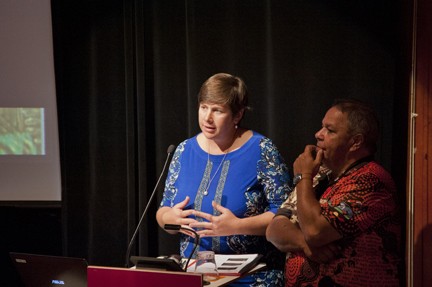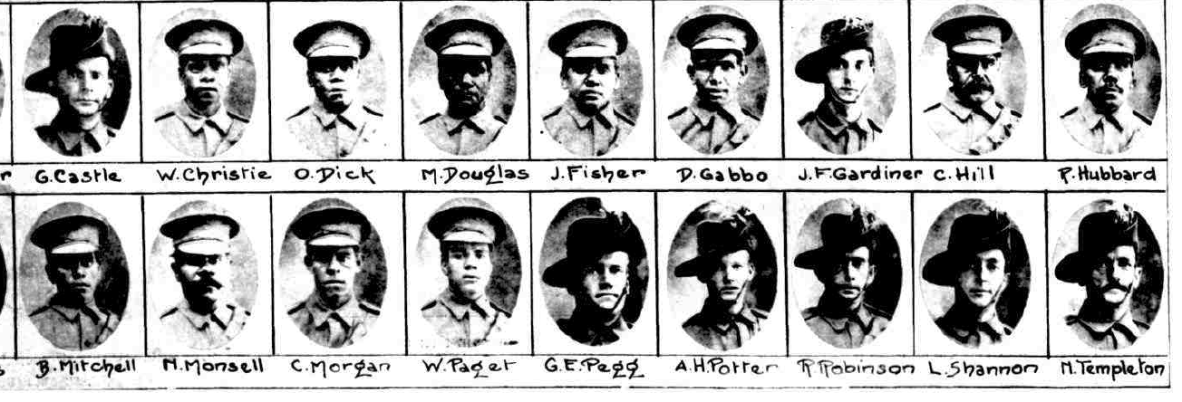
Boys from Barambah - cover page.
On April 21, The Ration Shed Museum launched their publication The Boys from Barambah: The story of the Black Diggers of Barambah-Cherbourg of World War 1.

Sally Lawrence and Uncle Eric Law: Serving Country Forum.
This project is part of the Q ANZAC 100 Community Grants initiative and represents a labour of love for Aunty Sandra, Uncle Eric, Sally, Mark, Philippa and others involved in the project. Community members, including Elders and descendants provided the personal touch to the work of the research team. The booklet is one element of the project which also includes a video documentary, an exhibition and curriculum resources for use in schools.

The starting point for the project was an Honour Board at Cherbourg which listed 27 Aboriginal Men who served in WW1; the project uncovered a further 20 who served! Background research identifies the context of Aboriginal people at the time of WW1 and explores life under the Protection Act as well as the reasons for enlistment and serving country where Aboriginal people were not regarded as citizens.

Jack Norman .Research undertaken as part of the project uncovered 47 men from Barambah who enlisted in the AIF. Their stories of enlistment and service are central to the booklet and are complemented by images, records, newspaper clippings and other material that tell a hidden history of WW1. It tells the story of the Aboriginal men who fought and died on the Western Front; it celebrates the men of the Light Horse and the loyalty of Aboriginal men who enlisted.

William Christie .In addition to those who served, the men who volunteered only to be discharged for 'having irregularly enlisted' are recognised. Their stories are also an important part of the Barambah perspective on WW1. Often these men were stationed at the Training Depot in Brisbane for a period of 1-2 months before being formally discharged - in many instances their photographs appeared in The Queenslander newspaper as part of the reinforcements pages.

Reinforcements: Queenslander 28 July 1917.
This is a great publication and an excellent read for anyone wanting to gain an insight into the Aboriginal experience of WW1. Perhaps the most powerful part for me was the following letter from Thomas Blackman to Caroline Tennant-Kelly, an anthropologist working at Cherbourg in the 1930's.
I'm taken the pleasure of to you referring the treatment of half-caste return soldiers. I'm a return soldier myself as there were three of us went to the great war out of my family one was killed at war and two of us returned after the war was over. I always thought that fighting for our King and Country would make me naturalized British subject and a man with freedom in the country but I have hardly had freedom since I returned from the war I have no justice at all, I don't know if the King knows about how his half caste return soldiers are treated in this country. I'm a return soldier and on the roll and have had lots of votes and a member of the Labour party but I see that it ain't made me better off. I was brought to Cherbourg May 7th 1934 and still find myself here. is this the sort of freedom that I went to France and helped go fight? I say no. I wants justice. ...Thomas Blackman, Cherbourg Aboriginal Settlement. February 22, 1935.
Desmond Crump
Indigenous Languages Coordinator, Queensland Memory
State Library of Queensland Aboriginal and Torres Strait Islander Participation in WW1 webpages
References and Further Readings
Newman, M., Lawrence, S. and Scarlett, P. (2015) The Boys from Barambah: The story of the Black Diggers of Barambah-Cherbourg of World War 1.
Pratt, R. (1993) Biographical register of Queensland Aborigines who served in the Great War, 1914-1918. P 940.403 pra
Scarlett, P. (2011) Aboriginal and Torres Strait Islander volunteers for the AIF: the Indigenous response to World War One. Q 940.40994 SCA
Online Sources
The Ration Shed Museum – Cherbourg Memory.
Note: Copies of The Boys from Barambah can be purchased from The Ration Shed Museum.
Comments
Your email address will not be published.
We welcome relevant, respectful comments.